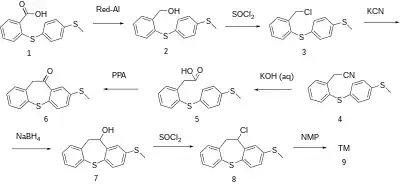 | |
| Clinical data | |
|---|---|
| Other names | Methiothepin; Methiothepine; Ro 8-6837 (maleate); VUFB-6276 (mesylate) |
| Identifiers | |
| |
| CAS Number |
|
| PubChem CID | |
| IUPHAR/BPS | |
| ChemSpider | |
| UNII | |
| ChEBI | |
| CompTox Dashboard (EPA) | |
| ECHA InfoCard | 100.261.496 |
| Chemical and physical data | |
| Formula | C20H24N2S2 |
| Molar mass | 356.55 g·mol−1 |
| 3D model (JSmol) | |
| |
| |
Metitepine (INN; developmental code names Ro 8-6837 (maleate), VUFB-6276 (mesylate)), also known as methiothepin, is a drug described as a "psychotropic agent" of the tricyclic group which was never marketed.[1] It acts as a non-selective antagonist of serotonin, dopamine, and adrenergic receptors[2][3][4] and has antipsychotic properties.[5]
Synthesis
The reduction of 2-(4-methylsulfanylphenyl)sulfanylbenzoic acid, CID:2733664 (1) gives [2-(4-methylsulfanylphenyl)sulfanylphenyl]methanol, CID:12853582 (2). Halogenating with thionyl chloride gives 1-(chloromethyl)-2-(4-methylsulfanylphenyl)sulfanylbenzene, CID:12853583 (3). FGI with cyanide gives 2-[2-(4-methylsulfanylphenyl)sulfanylphenyl]acetonitrile, CID:12853584 (4). Alkali hydrolysis of the nitrile to 2-[2-(4-methylsulfanylphenyl)sulfanylphenyl]acetic acid, CID:12383832 (5). PPA cyclization to 3-methylsulfanyl-6H-benzo[b][1]benzothiepin-5-one, CID:827052 (6). The reduction with sodium borohydride gives 3-methylsulfanyl-5,6-dihydrobenzo[b][1]benzothiepin-5-ol, CID:13597048 (7). Halogenating with a second round of thionyl chloride gives 5-chloro-3-methylsulfanyl-5,6-dihydrobenzo[b][1]benzothiepine, CID:12404411. Alkylation with 1-methylpiperazine [109-01-3] completed the synthesis of Metitepine (9).
See also
References
- ↑ J. Elks (14 November 2014). The Dictionary of Drugs: Chemical Data: Chemical Data, Structures and Bibliographies. Springer. pp. 815–. ISBN 978-1-4757-2085-3.
- ↑ Monachon MA, Burkard WP, Jalfre M, Haefely W (1972). "Blockade of central 5-hydroxytryptamine receptors by methiothepin". Naunyn Schmiedebergs Arch. Pharmacol. 274 (2): 192–7. doi:10.1007/BF00501854. PMID 4340797. S2CID 19577535.
- ↑ Dall'Olio R, Vaccheri A, Montanaro N (1985). "Reduced head-twitch response to quipazine of rats previously treated with methiothepin: possible involvement of dopaminergic system". Pharmacol. Biochem. Behav. 23 (1): 43–8. doi:10.1016/0091-3057(85)90128-5. PMID 2994121. S2CID 29894323.
- ↑ Roth BL, Driscol J. "PDSP Ki Database". Psychoactive Drug Screening Program (PDSP). University of North Carolina at Chapel Hill and the United States National Institute of Mental Health. Retrieved 14 August 2017.
- ↑ Lemke TL, Williams DA (24 January 2012). Foye's Principles of Medicinal Chemistry. Lippincott Williams & Wilkins. pp. 388–. ISBN 978-1-60913-345-0.
- ↑ Jílek JO, Metyšová J, Svátek E, Jančik F, Pomykáček J, Protiva M (1973). "Neurotropic and psychotropic agents. LVI. Sulfoxides, N-oxides and sulfones derived from neuroleptic 10-piperazino-10, 11-dihydrodibenzo [b, f] thiepins". Collection of Czechoslovak Chemical Communications. 38 (2): 599–610. doi:10.1135/cccc19730599.
- ↑ Jílek J, Pomykáček J, Dlabač A, Bartošová M, Protiva M (1980). "Neuroleptics of the 8-methylthio-10-piperazino-10, 11-dihydrodibenzo [b, f] thiepin series: New compounds and new procedures". Collection of Czechoslovak Chemical Communications. 45 (2): 504–516. doi:10.1135/cccc19800504.
- ↑ Pelz K, Jirkovsky L, Adlerova E, Metysova J, Protiva M (1968). "Über die in 8-Stellung durch die Methyl-, tert. Butyl-, Methoxy-, Methylthio-und Methansulfonylgruppe substituierten 10-(4-Methylpiperazino)-10,11-dihydrodibenzo [b, f] thiepin-Derivate". Collection of Czechoslovak Chemical Communications. 33: 1895–1910. doi:10.1135/cccc19681895.
External links
- Methiothepin at the U.S. National Library of Medicine Medical Subject Headings (MeSH)
